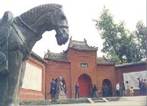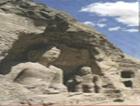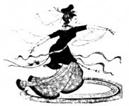Nearly all kids have had the same experience. They are eating in a restaurant with their parents. They finished the spaghetti minutes ago. Now, they are bored. Their little brother is kicking them under the table. He is also complaining about the desserts(餐后甜点). Yet their parents are still eating and talking…and talking…and talking.
“Be patient.” One parent says. “We’ll have dessert soon.”
All kids know what happens next. After dessert, their parents drink coffee. Then they talk some more. Again, the children must wait. They have been in school all day and would rather be running and playing. Instead, they must sit in a chair and stare at a wall.
Going to a restaurant doesn’t have to be this way. Many restaurants say they are “family-friendly”. Family restaurants, such as fast-food restaurants should play areas for children. At these restaurants, almost every play area is a big room full of climbing equipment. The room is usually, packed with happy kids. Parents can eat while the children play. Everyone is happy.
The real problem begins when families want to eat a fancier meal(大餐). The parents don’t want to hurry through the meal but talk to each other. They do not have bored children pestering(烦扰) them about leaving. That’s no fun for kids either. For them, going to a nicer restaurant means just one thing: sit still and be quiet.
On family blogs across the Web, dozens of parents post the same question all the time; are there any nicer restaurants with play areas for kids? Research shows that some nicer restaurants do have play areas. In warmer cities, it is easier for restaurants to build play areas outside. For example, at one restaurant kids can sail tiny little motor boats in a small, shallow pond. Parents can sit on a beautiful yard and watch the kids play. Some nicer restaurants even have indoor play areas. Research also shows that these restaurants serve more than just burgers, chickens and fries.
So, it’s possible for a restaurant to provide both food and a place where kids can play. These restaurants seem to be popular, too. For some, families must have reservation days in advance. For others, families might be forced to wait in long lines. Clearly, quality food and safe play areas are both good for business.
小题1:Why do children get unhappy at the restaurant?
A.Because they can’t join in their parents’ talk.
B.Because the dessert isn’t served in time.
C.Because they can do nothing but wait.
D.Because the food there isn’t delicious.小题2:What is the real problem mentioned in the passage?
A.Children don’t like eating fancier food.
B.Not many nicer restaurants provide play areas.
C.Parents don’t trouble to comfort their bored kids.
D.People have to wait for seats in nicer restaurants.小题3:What conclusion can we draw from the research?
A.It’s common for nicer restaurants to provide good food and play areas.
B.Building play areas is more difficult for restaurants in colder cities.
C.Serving more kinds of foods may help restaurants to make more money.
D.It’s possible for restaurants to find a balance to make both happy.小题4:What does the writer mainly want to tell us?
A.Cities need to help develop restaurant business.
B.Children are supposed to be much more patient.
C.Restaurants are supposed to give kids some space.
D.Parents need to care more about their kids when eating.
小题1:C
小题2:B
小题3:D
小题4:C
题目分析:这篇短文讲述家长在带孩子出去吃饭时,孩子们很不开心。因为除了等待没有可做的事情,尽管有些快餐店提供孩子们游玩的区域,但是并不是所有的饭店都有这项服务。因此,作者呼吁餐馆应该为孩子们提供娱乐的区域。
小题1:细节理解题。根据第三段最后Again, the children must wait. They have been in school all day and would rather be running and playing. Instead, they must sit in a chair and stare at a wall.可知,在餐馆里吃饭的孩子除了等什么也做不了。故选C。
小题2:细节理解题。第五段提到:当家人去吃大餐时,并没有供孩子娱乐的区域。以及第六段第一行are there any nicer restaurants with play areas for kids?可知不是所有的好点的饭店都提供娱乐区域。故选B。
小题3:推理判断题。根据最后一段第一行So, it’s possible for a restaurant to provide both food and a place where kids can play.提示,可知选D。
小题4:主旨大意题。本文主要讲述家长在带孩子出去吃饭时,孩子们除了等待没有可做的事情。故选C,餐馆应该设法为孩子们提供一些区域。



 材料一
材料一